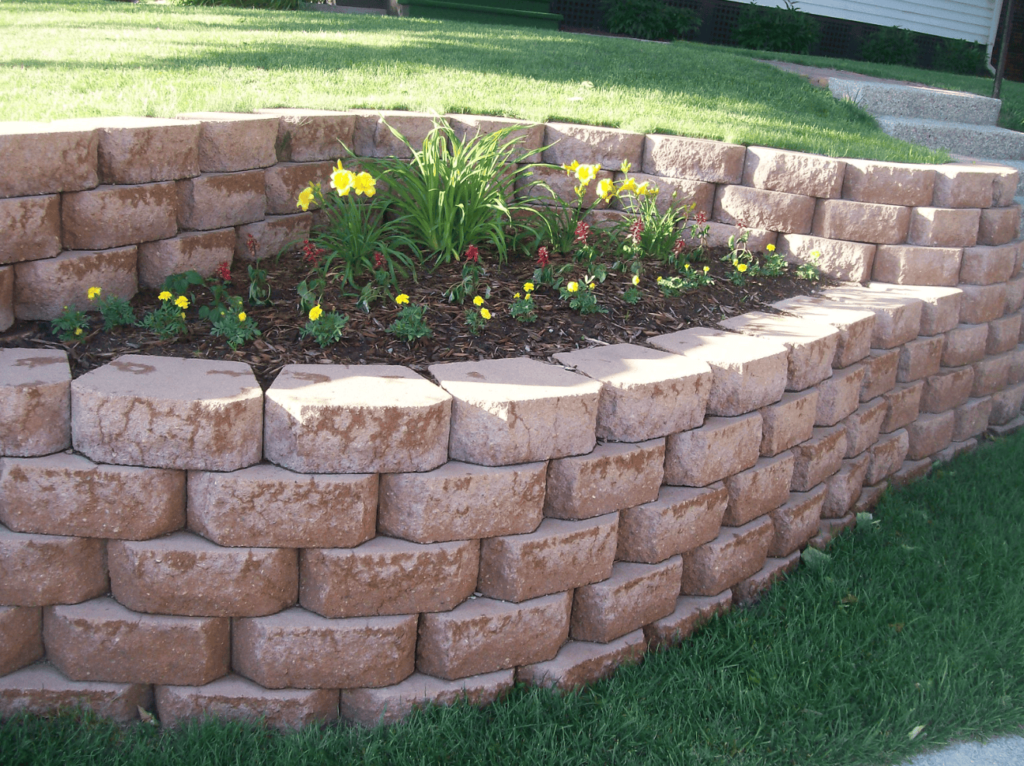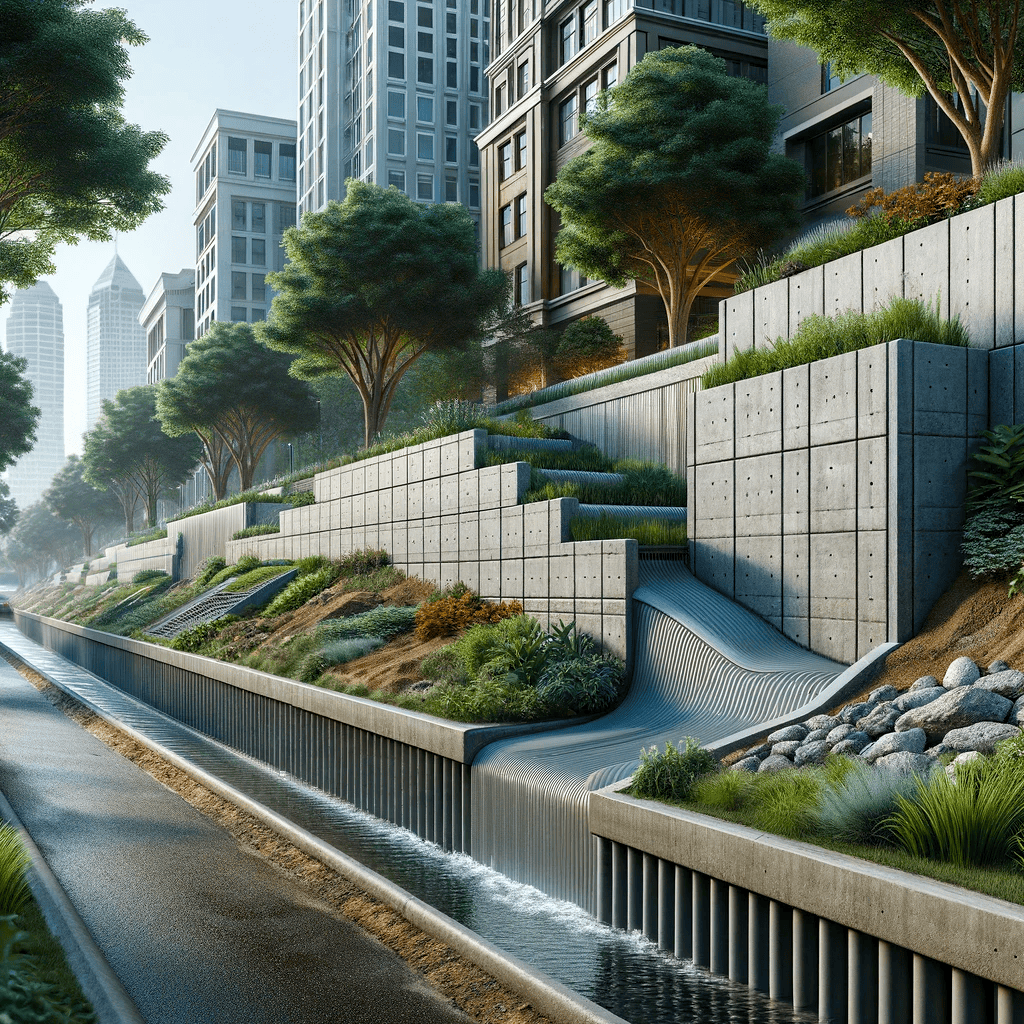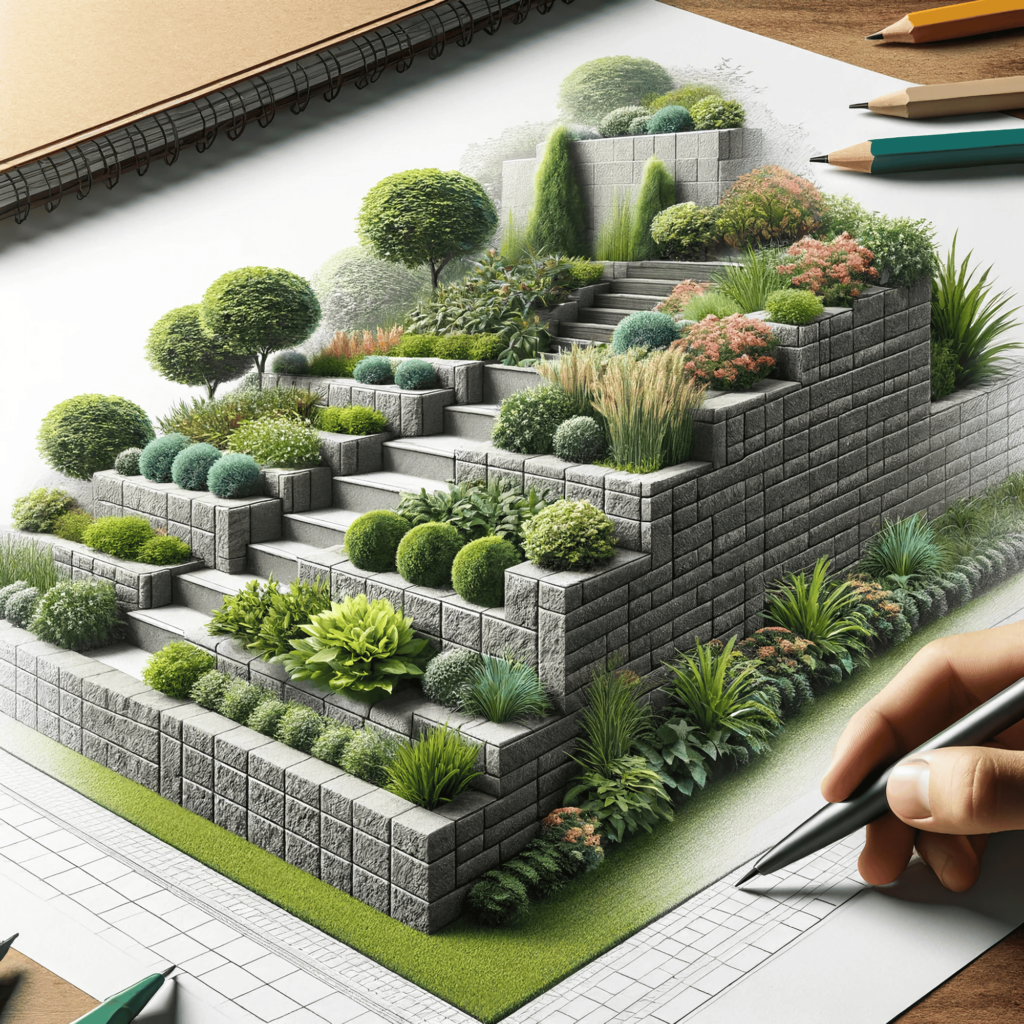Introduction to Effective Retaining Wall Drainage
Effective retaining wall drainage is paramount in the realm of construction and landscaping, where retaining walls play a critical role in defining both the integrity and aesthetics of a landscape. The often overlooked yet crucial component fundamentally determines the strength and durability of these walls.
At the core of every successful retaining wall project undertaken by the Clayborn Group lies a deep understanding of the importance of proper water management. It’s a common misconception that the robustness of a retaining wall is solely dependent on the materials and construction techniques. While these are undoubtedly significant, the longevity and stability of these structures are equally contingent on how well they handle the most persistent and pervasive challenge – water.
In regions across Indiana and Kentucky, where the Clayborn Group has established its expertise, the varying climatic conditions and diverse soil types add layers of complexity to this challenge. From the rolling hills of rural Kentucky to the urban landscapes of Indiana, each project carries its unique set of demands, particularly when it comes to managing hydrostatic pressure and ensuring long-term resilience against water-induced damages.

As we delve into the nuances of effective retaining wall drainage, we embark on a journey through the technicalities, the challenges, and the solutions that make these structures not just visually appealing, but enduringly robust.
Welcome to the world of Effective Retaining Wall Drainage – a testament to the Clayborn Group’s commitment to excellence in every project.
Understanding Retaining Walls and Their Purposes
Retaining walls are more than mere barriers; they engineer solutions to address a variety of environmental and aesthetic challenges. Their primary role is to hold back soil in areas where abrupt changes in elevation are present, preventing erosion, managing water runoff, and creating usable flat areas on slopes. The scope of retaining walls extends beyond functionality; they also contribute significantly to the aesthetic appeal of landscapes, offering a blend of utility and design.
Types of Retaining Walls
- Gravity Walls: These walls, often made from heavy materials like stone, concrete, or segmental blocks, rely on their mass to resist the pressure from behind.
- Cantilevered Walls: Engineered for strength, these walls use a lever arm and are typically made of reinforced concrete.
- Sheet Piling Walls: For tight spaces or soft soils, workers drive these thin walls deep into the ground.
- Anchored Walls: These walls use anchors for additional strength, making them suitable for high-load scenarios.
 Types of Retaining Walls, Wikipedia
Types of Retaining Walls, Wikipedia We choose each type of wall based on soil type, slope, load requirements, and aesthetic considerations to serve distinct purposes. Clayborn Group’s portfolio demonstrates a rich diversity in retaining wall projects, showcasing our adaptability and expertise across different wall types.
The Role of Retaining Walls in Landscaping and Construction
In the landscapes of Indiana and Kentucky, effective retaining wall drainage has played an instrumental role in transforming the terrain. They enable the creation of terraced gardens, support roads and pathways on slopes, and prevent soil erosion in areas prone to heavy rainfall. Additionally, architects can integrate retaining walls into the overall design to enhance a property’s visual appeal, making them a valuable ally in landscape design.
Understanding the purposes and types of retaining walls sets the foundation for grasping the importance of their most critical component – drainage. The next section will explore the science behind retaining wall failures, shedding light on the pivotal role that water plays in these structures’ stability.
The Science Behind Retaining Wall Failures
Understanding the mechanics of retaining wall failures is key to appreciating the importance of effective drainage systems. The deep knowledge of these fundamental principles underpins the Clayborn Group’s expertise in building resilient retaining walls.
The Role of Hydrostatic Pressure
The primary villain in the story of retaining wall failures is hydrostatic pressure. Water accumulating in the soil behind the wall, especially during heavy rains or snow melts, exerts this pressure. If not properly managed, the often underestimated and immense force can lead to wall bulging, cracking, or complete collapse.
For more comprehensive insights into the engineering principles of retaining walls, visit the American Society of Civil Engineers.
Soil Dynamics and Water
The type of soil behind the wall plays a crucial role. Soils like clay, with poor drainage characteristics, tend to retain water, increasing hydrostatic pressure. Conversely, sandy soils offer better drainage but might not provide the necessary stability without proper reinforcement.
Early Warning Signs of Wall Failure
- Bulging or Leaning: Visible deformations in the wall, indicating stress.
- Cracks and Gaps: Small fissures can develop into significant structural problems.
- Water Pools or Dampness: Signs of inadequate drainage behind the wall.
These symptoms underscore the importance of both initial proper construction and ongoing inspection and maintenance, areas where the Clayborn Group places significant emphasis.
Mitigating Risks with Effective Retaining Wall Drainage
The solution to mitigating hydrostatic pressure lies in an effective drainage system. This system relieves the pressure by providing a path for water to escape, rather than accumulating behind the wall. It involves more than just installing drainage pipes; it’s about understanding the site-specific conditions and tailoring the system accordingly.
In the next section, we will delve into the comprehensive guide to drainage in retaining walls, explaining how the Clayborn Group approaches this critical aspect to ensure the longevity and safety of its retaining wall projects.

Comprehensive Guide to Effective Retaining Wall Drainage
At Clayborn Group, we understand that the success of a retaining wall is heavily reliant on its drainage system. This section provides a detailed overview of the components and considerations that go into creating an effective drainage system for retaining walls.
Key Components of a Drainage System
- Drainage Stone: A layer of gravel or crushed stone placed behind the wall, facilitating water movement away from the wall.
- Filter Fabric: Non-woven fabric used to prevent soil from clogging the drainage stone.
- Perforated Drainage Pipe: A pipe, often at the base of the wall, to collect and redirect water away from the wall.
- Outlet Points: Strategically placed to release water and relieve pressure.
Designing an Effective Drainage System
The design of a drainage system varies based on wall type, soil conditions, and environmental factors. Here’s how we approach it:
- Assessing Site-Specific Conditions: Every site is unique, and we tailor our drainage solutions to match. This includes analyzing soil type, wall height, and expected rainfall.
- Choosing the Right Materials: We select appropriate drainage stones and filter fabrics that suit the specific requirements of each project.
- Strategic Placement of Drainage Pipes: We place pipes where they can most effectively collect and redirect water. Their placement and slope are critical to ensuring efficient water flow.
- Regular Inspection Points: We incorporate features that allow for easy inspection and maintenance of the drainage system.
Installation Best Practices
Proper installation of a drainage system is as crucial as its design. At Clayborn Group, we follow stringent installation standards to ensure that we correctly place and secure every component of the drainage system for optimal performance.

The Importance of Tailored Solutions
We recognize that there is no one-size-fits-all solution when it comes to effective retaining wall drainage. Our years of experience across diverse landscapes in Indiana and Kentucky have equipped us with the knowledge to design and implement drainage systems that are not only effective but also enduring.
In the next section, we will explore real-world case studies to demonstrate the impact of proper and improper drainage in retaining wall construction.
Case Studies of Retaining Wall Failures and Successes
Theoretical knowledge of retaining wall construction and drainage is vital, but real-world examples provide invaluable insights. Here, we present a few case studies that highlight the consequences of inadequate drainage and the triumphs of well-executed drainage systems in retaining wall projects.
Case Study 1: The Downfall of Insufficient Drainage
- Location: Rural Kentucky
- Problem: A large retaining wall without proper drainage stone or outlets.
- Outcome: The wall, after a season of heavy rainfall, showed significant bulging and eventually collapsed.
- Analysis: This failure was a direct result of hydrostatic pressure build-up. The absence of a drainage path for water caused immense pressure on the wall.
Case Study 2: Success Through Meticulous Drainage Planning
- Location: Suburban Indiana
- Project: A terraced garden retaining wall.
- Solution: Comprehensive drainage system with graded stones, filter fabric, and strategically placed drainage pipes.
- Result: Despite heavy rains, the wall has remained stable and functional for years, showcasing the effectiveness of a well-planned drainage system.
Lessons Learned
These contrasting scenarios underline the stark difference between failure and success in retaining wall construction. The key takeaway is that proper drainage planning and execution are non-negotiable aspects of retaining wall construction, and they play a critical role in the longevity and safety of these structures.
Through these experiences, the Clayborn Group has honed its expertise, ensuring thorough planning and high-quality execution for the drainage systems in every project we undertake.
In the following section, “Advanced Techniques in Drainage Management,” we will delve into the innovative methods and materials that are setting new standards in retaining wall construction.
Advanced Techniques in Effective Retaining Wall Drainage
Embracing innovation and technological advancements is at the heart of the Clayborn Group’s approach to retaining wall construction. In this section, we delve into the cutting-edge techniques and materials that are revolutionizing drainage management in retaining wall systems.
Innovative Drainage Materials
- Geocomposite Drainage Layers: These synthetic layers, increasingly used in challenging soil conditions, offer superior drainage capabilities compared to traditional gravel.
- Hydrophilic Geotextiles: These fabrics not only filter but actively draw water away from the wall, enhancing the drainage efficiency.
Technological Integration
- Water Flow Sensors: Advanced projects may include sensors to monitor moisture levels and water flow behind the wall, providing real-time data to anticipate potential issues.
- Computer-aided Design (CAD): We utilize CAD for precise planning of drainage systems, ensuring optimal placement and effectiveness.
Sustainable Drainage Solutions
- Rain Gardens and Bioswales: Integrating these ecological features not only aids in drainage but also enhances the environmental value of the project.
- Permeable Pavers: Used in conjunction with retaining walls to facilitate surface water infiltration, reducing the load on the wall’s drainage system.
Case Studies in Innovation
- Project 1: A complex urban project where we used geocomposite drainage layers to address space and soil limitations, resulting in a highly efficient and space-saving solution.
- Project 2: A large-scale landscape project where integrated bioswales effectively managed surface runoff, reducing the hydraulic load on the retaining walls.
These advancements in drainage management not only improve the functionality and longevity of retaining walls but also contribute to environmental sustainability. The Clayborn Group stays at the forefront of these technologies, ensuring that our projects not only meet but exceed industry standards.
In the next section, “Maintenance Tips for Longevity of Retaining Walls,” we will share some essential tips for preserving the integrity of your retaining wall over time.
Maintenance Tips for Longevity of Retaining Walls
Proper maintenance is crucial for ensuring the longevity of a retaining wall. At Clayborn Group, we believe that a well-maintained wall is a lasting wall. Here are some key maintenance tips to help keep your retaining wall in optimal condition:
Regular Inspection
- Schedule Bi-annual Inspections: Check for any visible signs of wear, such as cracks, bulging, or leaning.
- After Extreme Weather: Inspect the wall following heavy rainfall, snow, or freeze-thaw cycles, as these conditions can accelerate wear.
Drainage System Maintenance
- Keep Drainage Paths Clear: Regularly clear any debris that might block the weep holes or drainage outlets.
- Inspect Drainage Pipes: Regularly check the pipes to confirm they are unclogged and efficiently moving water away from the wall.
Vegetation and Erosion Control
- Manage Plant Growth: Keep an eye on tree roots and shrubbery that might grow near the wall, as roots can cause structural issues.
- Erosion Checks: Look for signs of soil erosion behind and around the wall, as this can indicate drainage problems.
Minor Repairs
- Promptly Address Small Issues: Small cracks or shifts should be repaired quickly to prevent them from becoming larger problems.
Professional Assistance
- Consult Experts for Major Concerns: If significant issues are detected, it’s crucial to consult with professionals like the Clayborn Group for expert advice and repair services.
Adhering to these maintenance practices will not only extend the life of your retaining wall but also ensure its safety and functionality. Remember, preventative maintenance is key to avoiding costly repairs in the future.
In the upcoming section, “Legal and Safety Considerations,” we will discuss the regulatory aspects and safety standards associated with retaining wall construction.
Legal and Safety Considerations in Effective Retaining Wall Drainage Construction
When it comes to constructing effective retaining wall drainage, adhering to legal standards and safety considerations is not just a matter of compliance, but a commitment to the well-being of the community. Clayborn Group takes these aspects seriously, ensuring that every project we undertake meets and exceeds these requirements.
Understanding Local Regulations
- Building Codes: Familiarize yourself with local building codes which dictate the specifications for retaining wall construction.
- Permits: Most regions require permits for retaining wall construction, especially for walls above a certain height.
Safety Standards
- Engineering Assessments: For walls of significant height or in complex terrains, it’s crucial to involve engineering assessments to ensure structural integrity.
- Proper Drainage: As highlighted throughout this article, effective drainage is not just an engineering concern but also a safety one, preventing wall failure and potential hazards.
Liability and Insurance
- Professional Liability Insurance: Ensure that your contractor, like the Clayborn Group, has adequate liability insurance to cover any unforeseen events.
- Warranty on Workmanship: Check for warranties that provide assurance on the quality and longevity of the construction.
Environment and Community Impact
- Environmental Considerations: Assess the environmental impact of the construction, ensuring minimal disturbance to the surrounding ecology.
- Community Involvement: For larger projects, community involvement and feedback can be crucial in addressing public safety and aesthetic concerns.
Adherence to these legal and safety considerations is not just about fulfilling regulatory requirements; it’s about building trust and ensuring the safety and satisfaction of every stakeholder involved.
In the final section, “Conclusion,” we will wrap up our comprehensive exploration of effective retaining wall drainage and maintenance.

Conclusion: The Pillars of Successful and Effective Retaining Wall Drainage
As we conclude this comprehensive exploration into effective retaining wall drainage, it’s clear that the key to success lies in two fundamental pillars: effective drainage and diligent maintenance. These elements are not just add-ons but integral components that determine the longevity, safety, and aesthetic value of retaining walls.
At Clayborn Group, our commitment to excellence in every project is underpinned by a deep understanding of these principles. From the initial design phase to the final touches of construction, and through the ongoing maintenance, our focus remains steadfast on delivering retaining walls that are not only visually appealing but structurally sound and enduring.
Building More Than Walls
We understand that retaining walls are more than mere structures; they are integral parts of people’s homes, businesses, and communities. They hold back not just soil but are foundational in creating safe, beautiful, and usable spaces.
A Commitment to Quality and Safety
Our dedication to incorporating advanced drainage techniques, adhering to safety standards, and staying abreast of legal requirements reflects our commitment to quality and safety in every project.
Inviting Collaboration and Questions
As experts in the field, we invite homeowners, developers, and landscape enthusiasts to collaborate with us in their journey to build effective and lasting retaining walls. For any questions or to discuss your next project, we encourage you to reach out to the Clayborn Group.
Thank you for joining us in this detailed journey through the world of retaining wall drainage and maintenance. We look forward to being your partner in crafting landscapes that are not only beautiful but built to last.
For an in-depth understanding of our tailored retaining wall solutions and to receive a personalized quote that aligns with your unique requirements, the Clayborn Group extends an invitation for a free consultation. We are committed to addressing your specific needs with our expertise. To initiate this process and discover the difference our dedicated team can make in your project, simply click the button below. This will direct you to our contact form, where you can share your project details and start your journey towards durable and aesthetically pleasing retaining walls.
